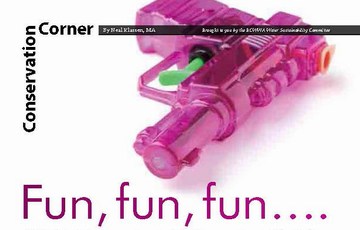Conservation Corner: Fun, fun, fun……..

At the Odenplan shopping plaza in Stockholm, Sweden, someone asked the question, “Can we get more people to take the stairs by making it fun to do?” So, they retrofitted the stairs next to an escalator to make them look like the keys on a piano. Then they wired each step so it played a musical note when stepped on.
You can see if the question was answered by checking out TheFunTheory.com.
The Fun Theory is an initiative by Volkswagen. It is based on the idea that fun is  the easiest way to change behaviour for the better. In another example on the website, a garbage can in a park was wired with a device that would create a sound like a stone dropped into a bottomless pit every time a piece of garbage was dropped in. In one day, this garbage can received almost twice the garbage as the regular cans.
the easiest way to change behaviour for the better. In another example on the website, a garbage can in a park was wired with a device that would create a sound like a stone dropped into a bottomless pit every time a piece of garbage was dropped in. In one day, this garbage can received almost twice the garbage as the regular cans.
When designing water conservation programs, all too often we focus on the financial incentive: save water, save money. But, in a province with relatively low water rates – and, in many cases, flat rates – how much financial incentive is there to take many of the steps necessary to significantly reduce water use? Can we make water efficiency fun?
For years, I used to drag a Water Recirculating Squirt Gun Shooting Gallery around to festivals and other outdoor events. In this game, children would shoot the squirt gun at a target. If they hit it, the target would drop, revealing a water conservation tip. The water would drain into a bin which was connected back to the squirt gun with a hose. It was the Fun Theory in action.
Last January, the EECO Heroes (Environmental Educators of the Central Okanagan) staged the Environmental E-lympics in local schools. In the morning, students received in-class presentations on water conservation, waste reduction and wildlife protection. In the afternoon, they gathered for an assembly in which their knowledge was tested through a series of fun competitions. The winning students received gold, silver or bronze medals, which were simply recycled CDs with stickers on them. Students took the competitions so seriously you would have thought they were the real Olympics.
These were great activities for kids, but how can we make water efficiency fun and engaging for adults?
If I was a technical guy, I would invent an irrigation timer that worked off your home computer. It would be easy to program with big, colourful buttons. ‘Drowning flowers’ would cry out if you were watering too much, or if you let the sprinkler run after a rain event. ‘Happy grass’ would congratulate you when you were watering efficiently. I am sure this kind of timer would work better than one that is tucked away in a dusty garage.
What about a water meter that could send you an email in which a talking toilet said, “Fix me, I’m leaking!” Or a shower timer that sang a rap song telling your teenager that his or her time was up? My washing machine plays a little tune when a load is finished. Surely, it could be programmed to prompt me to use the most water efficient setting before I start a load. Fun does not have to be funny, but it should be engaging.
In many places, water conservation is a serious issue, but that does not mean the path to water efficiency has to take a completely serious approach. The Fun Theory demonstrates that we can enjoy some laughs along the way to sustainable behaviour.
By Neal Klassen, BCWWA “Watermark” contributor
Originally published in the Spring 2010 issue of Watermark Magazine, the official publication of the British Columbia Water & Waste Association (BCWWA).
Posted April 2010

